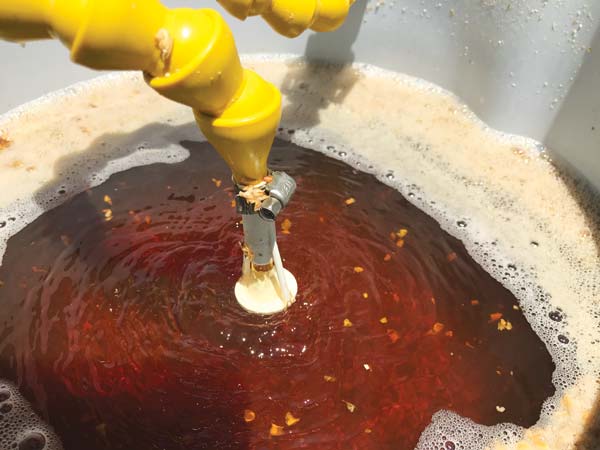Digging Into Sparge Water Temperatures
TroubleShooting
Barney Heller — North Wales, Pennsylvania asks,
I’m confused. Sparging is supposed to be done with a grain bed at 170 °F (76 °C). A lot of articles say to use sparge water at 170 °F (76 °C). If mashing is at 152 °F (67 °C), the grain temperature will never get up to 170 °F (76 °C). I’ve been using boiling water to get the grain bed up to 170 °F (76 °C). Is this wrong? What is the correct method?
A Hi, Barney. Based on your question I am assuming you are either relatively new to all-grain brewing or starting to question basic practices brewers follow. One thing I wish I knew when I began brewing is that there are lots and lots of different ways to brew great beer. And by extension there are no “correct” methods, just lots of options. Your question mixes best practices from infusion and multi-temperature mashing into a single goal that is out of sync with infusion mashing.

In your case, you are infusion mashing at 152 °F (67 °C). The term “infusion” mash can be confusing because it means different things to different brewers. I like the phrase “isothermal mash” because it leaves no room for miscommunication. German brewers use the term infusion to mean mashing that does not include mash boiling; infusion mashes may be isothermal or stepped mashes covering a broad range of temperatures, with or without a mash-off step. Like I said, this can be a bit confusing.
In a typical isothermal, commercial mash at 152 °F (67 °C), there is no increase in temperature before the onset of sparging because commercial infusion mash tuns are not equipped with heating jackets. The norm is to sparge with water at ~170 °F (76 °C) and allow the mash to heat up to some temperature between 152 °F (67 °C) and 170 °F (76 °C). Why? Because that’s how it’s done! There may be a more reasoned answer than that, but it’s not much different. And the answer is that the hot water tank is maintained at 170 °F (76 °C) because that’s a great strike water temperature for mashes at 152 °F (67 °C) and it’s also really handy to have strike and sparge water stored in the same tank.
Decoctions are always described to be a royal pain, but a single decoction at the end of a single temperature mash is pretty darn easy.
I am sure some readers are thinking about astringency and not wanting to sparge too hot. Yeah, yeah, but what about brewers using stepped mashing and/or decoctions? These brewers typically heat their mashes to ~170 °F (76 °C) at the end of the mash to fully convert the mash, stop enzymes, decrease viscosity, and to boost extract yield. They also sparge with 170 °F (76 °C) water.
Both methods work well and, in practice, infusion mashers usually leave a bit more extract in the spent grain bed for a variety of reasons, including their lower mash temperature during sparging. I like your method because it makes sense and does not just randomly heat up the mash. You are targeting 170 °F (76 °C), achieving your temperature boost with hot water, and then sparging normally.
If you ever want to get a little crazy and uber traditional at the same time, consider boiling about a third of your mash at the end of your rest at 152 °F (67 °C), then mixing this single decoction into your rest mash to achieve your mash-off temperature. Decoctions are always described to be a royal pain, but a single decoction at the end of a single temperature mash is pretty darn easy. And there are several benefits brewers can enjoy including a bump to your extra

